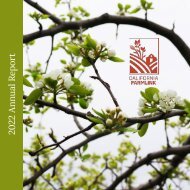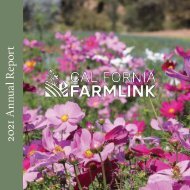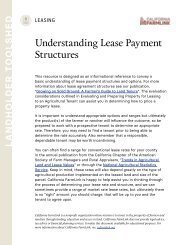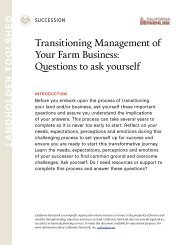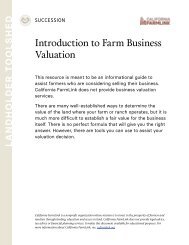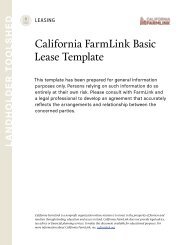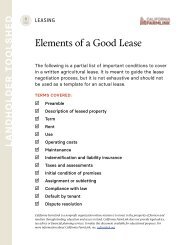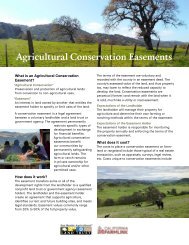Guide to Regenerative Grazing Leases: Opportunities for Resilience
California FarmLink and TomKat Ranch Educational Foundation teamed up to create this resource focused on land leases that support regenerative grazing practices. This guidebook aims to empower private, nonprofit, and public landholders, as well as easement-holders and grazing tenants.
California FarmLink and TomKat Ranch Educational Foundation teamed up to create this resource focused on land leases that support regenerative grazing practices. This guidebook aims to empower private, nonprofit, and public landholders, as well as easement-holders and grazing tenants.
You also want an ePaper? Increase the reach of your titles
YUMPU automatically turns print PDFs into web optimized ePapers that Google loves.
CHAPTER 3. Agricultural Management Plans (Continued)<br />
Goal-setting. Property-level goals, accompanied by objectives with enough<br />
specificity <strong>to</strong> in<strong>for</strong>m daily operations, provide the framework upon which work<br />
and measurements will be directed, in order <strong>to</strong> track success over time. (In<br />
this guidebook, property-level goals and practical objectives will be referred <strong>to</strong><br />
collectively as ‘goals.’) All goals should be Specific, Measurable, Achievable, Realistic,<br />
and Time-bound (SMART), and can be refined as moni<strong>to</strong>ring data is collected and<br />
lessons are learned through the adaptive management process.<br />
Attribute<br />
Description<br />
Specific<br />
The goal is concrete, detailed and well defined<br />
Measurable<br />
Achievable<br />
Realistic<br />
The goal focuses on an aspect of the system that can be<br />
moni<strong>to</strong>red<br />
The goal is achievable given the resources and context<br />
of the operation<br />
The goal is ecologically and operationally realistic<br />
Time-bound<br />
The goal is linked <strong>to</strong> a relevant time frame<br />
<strong>Regenerative</strong> operations often set goals that consider the system as a whole,<br />
including goals <strong>for</strong> improving <strong>for</strong>age or lives<strong>to</strong>ck production and ecological outcomes<br />
like fostering biodiversity, rebuilding soil health, and improving water capture and<br />
retention, as just a few examples.<br />
Because most outcomes are inherently complex and difficult <strong>to</strong> measure in their<br />
entirety, ecological indica<strong>to</strong>rs are often used <strong>to</strong> moni<strong>to</strong>r success. SMART goals<br />
should be developed in relation <strong>to</strong> such indica<strong>to</strong>rs <strong>to</strong> ensure they are measurable, and<br />
that implementation and moni<strong>to</strong>ring can be achieved with a reasonable investment<br />
of time and money. In some cases, indica<strong>to</strong>r species (whose presence or absence<br />
provides in<strong>for</strong>mation on the ecological condition and function of a given landscape)<br />
can be moni<strong>to</strong>red as a cost-effective way <strong>to</strong> track progress <strong>to</strong>ward a SMART goal.<br />
© Copyright 2022 Cali<strong>for</strong>nia FarmLink and TomKat Ranch Educational Foundation<br />
34



